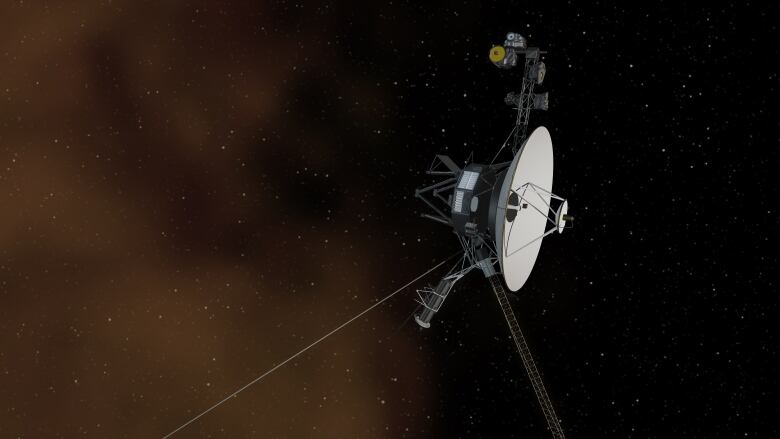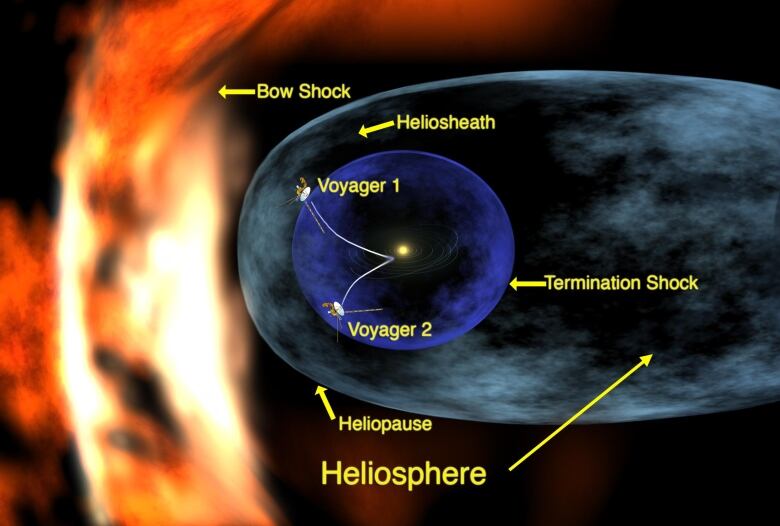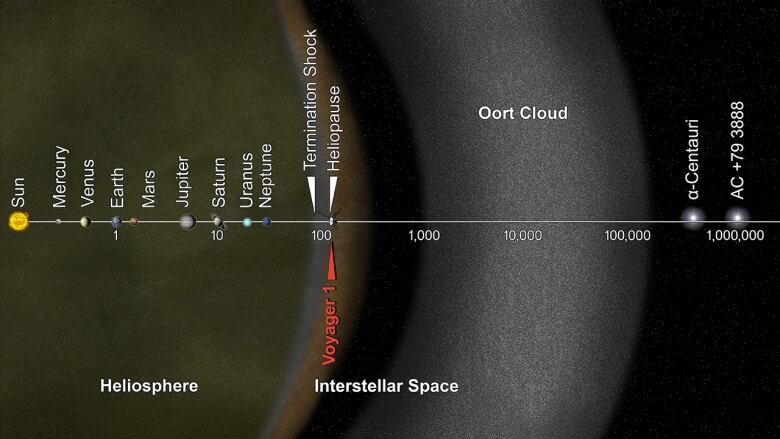NASA's 2 long-lived Voyager spacecraft explore the 'very empty' spaces between stars
Mission has extended to 40 years from 4, and now reveals details of a puzzling region

Forty years ago, NASA launched two Voyager spacecraft that opened our eyes on our solar system. Now these workhorses are exploring regions of space we barely understand.
Originally, these two spacecraft were part of the a mission to study our outer planets: Jupiter, Saturn, Uranus and Neptune. They presented us with an unprecedented view of not only these four giants, but alsoour own home.

But now these spacecraft are at the edgeof our solar system in a region never before explored: interstellar space, the region between stars.
"I don't think anyone on the team thought they'd still be getting data from it 40 years after launch,"Eric Christian, a scientist on the Voyager team, told CBC News.
While it wasn't certain how long the Voyagers would last, they've certainly gone beyond their original four-year mission. Given an extension the Interstellar Mission scientists hope to learn far more about this puzzling region of space.
It's so puzzlingthat scientists couldn't even agree when Voyager 1 actually lefttheheliopause, a bubble where the solar wind that carries charged particles to the edges of our solar system ends.
This is our next step to the stars.Eric Christian, Voyager scientist
Ed Stone, a Voyager project scientist and a physics professor at Caltech, spoke with Quirks and Quarks' Bob McDonald about the Interstellar Mission and explained how scientists had determined Voyager 1 had indeed crossed into interstellar space.
"One of the key signatures was the abrupt increase in cosmic radiation once we left the bubble," Stone said.
"Suddenly we saw the full intensity of what's outside. It's four times more intense outside than it ever gets inside at Earth, for instance;something we did not know before."
A bubble in space
There are three distinct regions to our bubble: the heliosphere, the area of solar wind; the heliosheath, the outer region of the heliosphere where solar wind is believed to abruptly slow down, which results in something called a termination shock; and the heliopause, the boundarybetween the solar wind and interstellar wind, where the two are balanced.
And while we can see every day that Earth is revolving, what we're not aware of is how our solar system is flying through space at roughly 828,000 km/h. And because of that, it creates a bow shock, like a boat moving through water.

So scientists want to better understand what's going on in these distant regions, and they're using the Voyager spacecraft to do it.They'll be able to measure things such as cosmic radiation, the solar wind and even how long it takes a fast-moving ejection from the sun, called a coronal mass ejection, to reach the region (about 400 days).
And because thespacecraft are heading away from each other, scientists will get a better picture of differences in interstellar space.
"They're both more than 10 billion miles away from the Earth. But they're also more than 10 billion miles apart,"Christian said. "So seeing whether interstellar space looks the same at the two spacecraft will give us a lot more information on the variability between the stars."
40,000 years to the next star
For scientists working on the Voyagers, it's been an exciting time.
"As a scientist and as a human being, I think it's really neat that we've gotone, and we'll soon have two, spacecraft out in interstellar space, in the space between the stars,"Christian said."I mean this is our next step to the stars."
Voyager 1 is about 22 billion kilometres from Earth. And while NASA scientists believe Voyager 1entered interstellar space in August 2012, it will take Voyager 2 at a distance of roughly 17 billion kilometres a year or two to reach it.Scientists can't say for certain because we don't know the shape of theheliosphere.

Neither of the Voyager spacecraft will be able to explore other worlds, though: there simply isn't a lot out there. Stone explained that the next encounter with an object will occur in 40,000 years: a star calledAC +79 3888, which is 17.6 light-years from Earth.Even then, the spacecraft will be 1.6 light-years away from it.
"Space is immense, and it's empty. Very empty," he said.
Soit may be some time before another civilizationlistens to the Golden Record, a recording of sounds and music and directions to Earth meant to inform an alien species about Earth and humans.
The Voyager spacecraft are the first manmade objects to make it so far out into space. As Stone told McDonald, they will live out amongthe stars, completing one orbit every 225 million years.
"And it will be that way for billions of years,"he said."They will be our silent ambassadors sent from Earth."
You can listen to more on this onQuirks and Quarksairing on CBC Radio One on Sept. 9 at noon.
Corrections
- An earlier version of this story said the star AC +79 3888 was 17.6 billion light-years from Earth and Voyager would pass 16 light-years from it. AC +79 3888 is actually 17.6 light-years from Earth and the spacecraft will be 1.6 light-years from it.Sep 04, 2017 10:59 AM ET












_(720p).jpg)


 OFFICIAL HD MUSIC VIDEO.jpg)
.jpg)



























































































